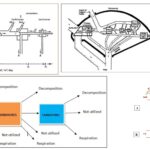A geneticist crossed wild, gray-colored mice with white (albino) mice. All the progeny were gray. These progeny were intercrossed to produce an F2, which consisted of 198 gray and 72 white mice. Propose an hypothesis to ex- plain these results, diagram the crosses, and compare the results with the predictions of the hypothesis.
A geneticist crossed wild, gray-colored mice with white (albino) mice. All the progeny were gray. These progeny were intercrossed to produce an F2, which consisted of 198 gray and 72 white mice. Propose an hypothesis to ex- plain these results, diagram the crosses, and compare the results with the predictions of the hypothesis.
Please login to submit an answer.
The gray and white coat colors in mice can be explained by a single gene with two alleles:
- G: Gray allele (dominant)
- g: White allele (recessive)
Hypothesis:
- Gray (wild-type) mice are homozygous dominant (GG) or heterozygous (Gg).
- White (albino) mice are homozygous recessive (gg).
Crosses and Diagrams
- Parental Generation (P):
- Gray (wild-type) × White (albino)
- Genotypes: GG or Gg × gg
- F1 Generation:
- If we assume the gray parent is heterozygous (Gg), then the cross is Gg × gg.
The Punnett square for this cross would be:
G g g Gg gg g Gg gg F1 Genotypes:
- Gg (Gray): 50%
- gg (White): 50%
F1 Phenotypes:
- Gray: 50%
- White: 50%
- F2 Generation:
- Intercross F1 progeny (Gg × Gg):
The Punnett square for this cross would be:
G g G GG Gg g Gg gg F2 Genotypes:
- GG: 1/4
- Gg: 1/2
- gg: 1/4
F2 Phenotypes:
- Gray (GG or Gg): 3/4
- White (gg): 1/4
Comparison with Results
Observed F2 Results:
- Gray: 198
- White: 72
- Total: 198 + 72 = 270
Expected Ratios:
- Gray: 3/4 of 270 = 202.5
- White: 1/4 of 270 = 67.5
Chi-Square Calculation:
[latex] chi^2 = frac{(O – E)^2}{E} [/latex]
[latex] text{For Gray mice:} [/latex]
[latex] frac{(198 – 202.5)^2}{202.5} approx frac{(-4.5)^2}{202.5} approx 0.1 [/latex]
[latex] text{For White mice:} [/latex]
[latex] frac{(72 – 67.5)^2}{67.5} approx frac{4.5^2}{67.5} approx 0.3 [/latex]
[latex] text{Total } chi^2 text{ value:} [/latex]
[latex] chi^2 approx 0.1 + 0.3 approx 0.4 [/latex]
[latex] text{Degrees of Freedom: 1 (since there are 2 phenotypes)} [/latex]
[latex] text{Critical Value: For 1 degree of freedom at a 0.05 significance level, the critical value is 3.841.} [/latex]
[latex] text{Since } chi^2 approx 0.4 text{ is less than 3.841, we fail to reject the null hypothesis.} [/latex]
- Share on Facebook
- Share on Twitter
- Share on LinkedIn
Helpful: 0%




